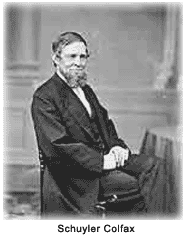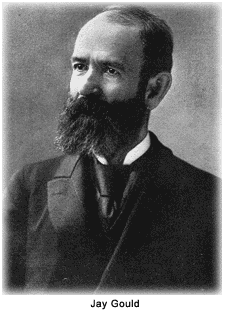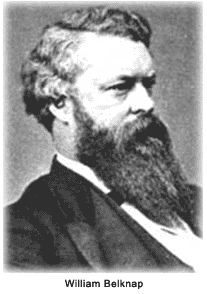Grant Administration Scandals
The postwar era was marked by widespread political corruption. Dishonest Scalawags and Carpetbaggers enriched themselves in state and local governments of the South during Reconstruction. Cities in the North were not immune to the prevailing greed where the infamous Tweed Ring of New York City set the standard for urban corruption. On the national level the two Grant administrations established a woeful record, although few doubted the president`s personal honesty.
 Major scandals included the following:
Major scandals included the following:
- Credit Mobilier
. Representative Oakes Ames of Massachusetts and Thomas C. Durant were prominent stockholders in the Union Pacific Railroad. In 1867 the two cooperated in forming Crédit Mobilier, a dummy construction company fobbed off as responsible for completing the transcontinental railway`s last 600 miles. In the process, U.P. stockholders and the federal government were bilked out of millions of dollars. When it appeared that an investigation was going to be launched, Ames bribed influential congressmen and was able to head off scrutiny.
Nevertheless, the fraud was exposed in 1872. It was apparent that Vice president Schuyler Colfax had been bribed with stock. House Speaker James A. Garfield was linked to the dealings, but his participation was never proven.
Despite the loss of $20 million (a huge sum in the 1870s), no prosecutions ever occurred.
- Black Friday
. In 1869, speculators Jim Fisk and Jay Gould attempted to corner the nation’s gold market. They enlisted the help of Grant’s brother-in-law, who had pledged to prevent the president from acting to ruin the scheme.
 The conspirators bought huge amounts of gold and gold futures, sending the price of the commodity spiraling upward. They intended to sell everything at an enormous profit. However, Grant came to realize that his brother-in-law’s advice was harming public confidence and he ordered the immediate sale of $4 million worth of government gold. The price plummeted. Thousands of people suffered financial losses – not including Fisk and Gould, who refused to pay off their obligations.
The conspirators bought huge amounts of gold and gold futures, sending the price of the commodity spiraling upward. They intended to sell everything at an enormous profit. However, Grant came to realize that his brother-in-law’s advice was harming public confidence and he ordered the immediate sale of $4 million worth of government gold. The price plummeted. Thousands of people suffered financial losses – not including Fisk and Gould, who refused to pay off their obligations.
- The Whiskey Ring
. In the years following the Civil War, federal liquor taxes were raised to extremely high rates to help pay off the cost of the fighting. In order to avoid the high tax, many of the nation’s distillers bribed officials in the Department of the Treasury, receiving tax stamps at a fraction of their face value. Treasury Secretary Benjamin H. Bristow eventually caught wind of the dishonesty and launched a massive investigation. In the end, more than 100 officials were convicted. Grant, much to his discredit, successfully shielded his private secretary, Orville E. Babcock.
- The Indian Ring
. Grant’s Secretary of War, William W. Belknap, accepted bribes from companies with licenses to trade on the reservations of many Native American tribes.
 Belknap was impeached by the House of Representatives, but acquitted by the Senate in August 1876.
Belknap was impeached by the House of Representatives, but acquitted by the Senate in August 1876.
The frequency of these events led to the use of the term “Grantism,” a word synonymous with greed and corruption. Many people at the time speculated that money from these ventures was being funneled into Republican Party coffers.
These unsavory dealings led to the establishment of a
Liberal Republican Party.
The true villain in these scandals was the
spoils system, in which successful officeholders rewarded their supporters with political appointments. An ever-growing part of the population began to recognize the need for some type of
civil service reform.
 Major scandals included the following:
Major scandals included the following:
 The conspirators bought huge amounts of gold and gold futures, sending the price of the commodity spiraling upward. They intended to sell everything at an enormous profit. However, Grant came to realize that his brother-in-law’s advice was harming public confidence and he ordered the immediate sale of $4 million worth of government gold. The price plummeted. Thousands of people suffered financial losses – not including Fisk and Gould, who refused to pay off their obligations.
The conspirators bought huge amounts of gold and gold futures, sending the price of the commodity spiraling upward. They intended to sell everything at an enormous profit. However, Grant came to realize that his brother-in-law’s advice was harming public confidence and he ordered the immediate sale of $4 million worth of government gold. The price plummeted. Thousands of people suffered financial losses – not including Fisk and Gould, who refused to pay off their obligations.
 Belknap was impeached by the House of Representatives, but acquitted by the Senate in August 1876.
Belknap was impeached by the House of Representatives, but acquitted by the Senate in August 1876.